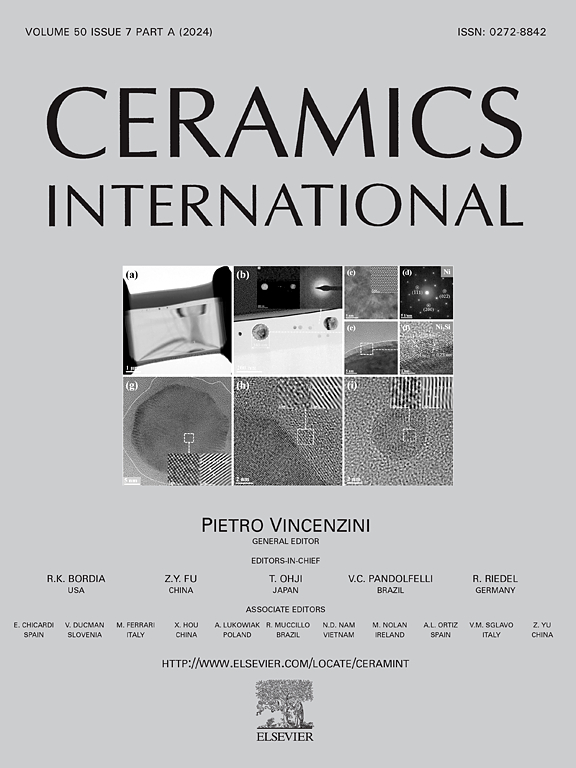机械抛光对低碳钢微弧氧化涂层摩擦和耐蚀性的影响
IF 5.1
2区 材料科学
Q1 MATERIALS SCIENCE, CERAMICS
引用次数: 0
摘要
研究了机械抛光(MP)后处理对低碳钢微弧氧化(MAO)涂层耐摩擦和耐腐蚀性能的影响。采用MAO和MP相结合的方法在低碳钢表面制备了复合涂层。采用扫描电镜(SEM)、能谱仪(EDS)、x射线衍射仪(XRD)和x射线光电子能谱仪(XPS)研究了涂层中α-Al2O3和FeAl2O4的形成机理。实验结果表明,MP后处理使MAO涂层表面粗糙度显著降低至2.6 μm,并通过去除表面火山状突起而暴露出额外的高硬度α-Al2O3相。涂层的维氏硬度提高到1169.1 hv,比未抛光的MAO涂层提高了8.9%。摩擦试验表明,GCr15摩擦副在5N载荷作用下,MAO + MP涂层的体积磨损率为3.62 × 10−5 mm3/(N·m)。然而,由于涂层变薄和MP引起的显微组织变化,耐蚀性降低。本研究证实MAO和MP的协同作用显著提高了低碳钢的耐磨性。然而,必须考虑与防腐的权衡,为高载荷摩擦条件下的表面改性提供理论依据。本文章由计算机程序翻译,如有差异,请以英文原文为准。
Effect of mechanical polishing on friction and corrosion resistance of mild steel micro-arc oxidation coating
The study investigates the effect of mechanical polishing (MP) post-treatment on the friction and corrosion resistance of micro-arc oxidation (MAO) coatings applied to mild steel. A composite coating was prepared on mild steel by combining MAO and MP processes. The formation mechanism of α-Al2O3 and FeAl2O4 in the coating was investigated using scanning electron microscopy (SEM), energy dispersive spectrometry (EDS), X-ray diffraction (XRD), and X-ray photoelectron spectroscopy (XPS). Experimental results show that MP post-treatment significantly reduces the surface roughness of the MAO coating to 2.6 μm and exposes additional high-hardness α-Al2O3 phase by removing volcanic protrusions on the surface. As a result, the Vickers hardness of the coating increases to 1169.1 H V, which is 8.9 % higher than that of the unpolished MAO coating. The friction test shows that the volume wear rate of the MAO + MP coating is 3.62 × 10−5 mm3/(N·m) when tested with the GCr15 friction pair under a 5N load. However, the corrosion resistance decreases due to the thinning of the coating and microstructural changes induced by MP. This study confirms that the synergistic effect of MAO and MP significantly improves the wear resistance of mild steel. However, the trade-off with corrosion protection must be considered, providing a theoretical basis for surface modification under high-load friction conditions.
求助全文
通过发布文献求助,成功后即可免费获取论文全文。
去求助
来源期刊

Ceramics International
工程技术-材料科学:硅酸盐
CiteScore
9.40
自引率
15.40%
发文量
4558
审稿时长
25 days
期刊介绍:
Ceramics International covers the science of advanced ceramic materials. The journal encourages contributions that demonstrate how an understanding of the basic chemical and physical phenomena may direct materials design and stimulate ideas for new or improved processing techniques, in order to obtain materials with desired structural features and properties.
Ceramics International covers oxide and non-oxide ceramics, functional glasses, glass ceramics, amorphous inorganic non-metallic materials (and their combinations with metal and organic materials), in the form of particulates, dense or porous bodies, thin/thick films and laminated, graded and composite structures. Process related topics such as ceramic-ceramic joints or joining ceramics with dissimilar materials, as well as surface finishing and conditioning are also covered. Besides traditional processing techniques, manufacturing routes of interest include innovative procedures benefiting from externally applied stresses, electromagnetic fields and energetic beams, as well as top-down and self-assembly nanotechnology approaches. In addition, the journal welcomes submissions on bio-inspired and bio-enabled materials designs, experimentally validated multi scale modelling and simulation for materials design, and the use of the most advanced chemical and physical characterization techniques of structure, properties and behaviour.
Technologically relevant low-dimensional systems are a particular focus of Ceramics International. These include 0, 1 and 2-D nanomaterials (also covering CNTs, graphene and related materials, and diamond-like carbons), their nanocomposites, as well as nano-hybrids and hierarchical multifunctional nanostructures that might integrate molecular, biological and electronic components.
 求助内容:
求助内容: 应助结果提醒方式:
应助结果提醒方式:


